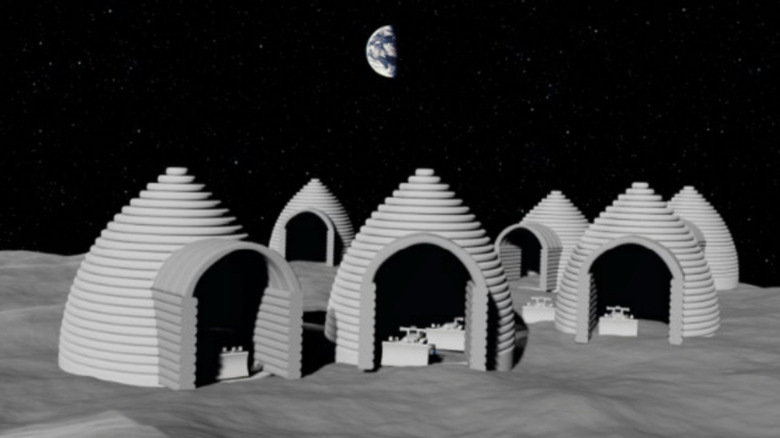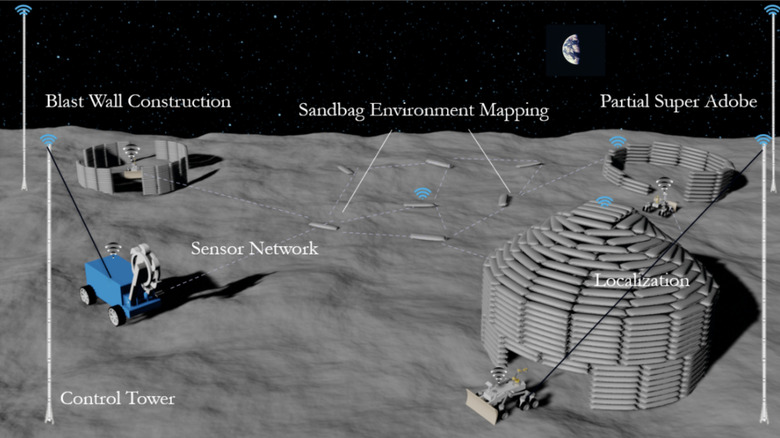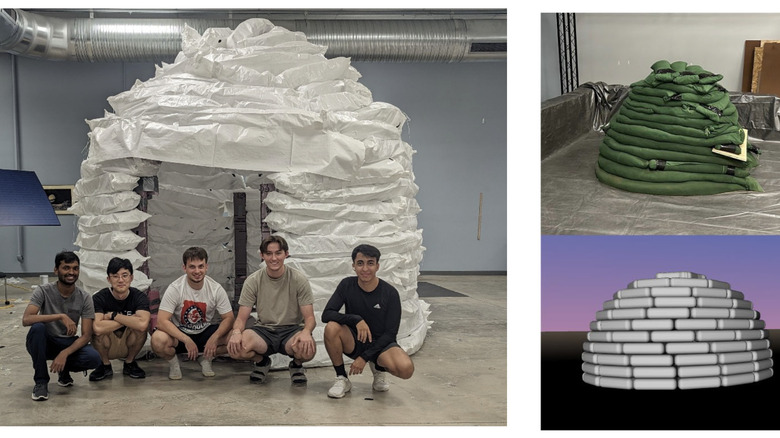How Termites Inspired This Lunar Shelter Design For NASA's Artemis Mission
NASA currently has its eyes set on the Artemis mission, but one of the most ambitious aspects of the mission is putting man back on the lunar surface, in addition to plans for a gateway that will orbit Earth's sole natural satellite. In the early missions, astronauts will spend just about a week on the moon, but the plans are to eventually establish a research habitat on Earth's sole natural satellite. The agency has plans to establish more than one base station on the lunar surface in partnership with its international collaborators to ensure maximum exploration coverage and boost the number of scientific experiments.
While that might sound aspirational, the agency has been researching and inviting ideas for decades now. The latest candidate draws inspiration from Mother Nature itself. A team from the University of Arizona has detailed plans for lunar structures to shelter NASA astronauts that are inspired by cathedral termite mounts. And just the way thousands of worker-class termites help build and reside in these structures that are found in Australia, the team plans to build these multipurpose sandbag shelters using robots.
The team calls it "smart, robot-built sandbag shelters." Led by Professor Jekan Thanga from the Department of Aerospace and Mechanical Engineering, the team has already created prototypes for their lunar sandbag structures and formulated the foundational idea for a robotic network capable of constructing them. The group is working with NASA's Jet Propulsion Laboratory and a robotics company to bring the idea to life.
Why termite mounds?
NASA has strategically earmarked candidate sites where ice is said to be accessible. But in building a base station, the agency must also keep in mind aspects such as securing a reliable power supply infrastructure, waste disposal systems, protection from radiation damage, solid sites for landing, and more. Doing so is no small feat, but a swarm of robots autonomously working like insects and making sandbag-based structures could be a feasible solution. "The structures contain sensors that aid in construction, then alert astronauts to changes in environmental conditions," notes the team.
The focus is on semi-permanent moon shelters before we can explore ideas for building larger and more sophisticated lunar architecture. Starting with something as simple as sandbag structures could be the optimal route for multiple reasons, and especially when a network of robots can accomplish the task with relative ease. Deriving inspiration from termites and their massive mounds has a handful of important functional benefits.
These mounds are extremely resilient, and their unique architecture allows air inflow as well as temperature regulations. Plus, the kind of desert-like environments they survive are analogous to the extreme conditions that astronauts will face on the moon. Notably, the sandbag structure also draws upon the idea of Nader Khalili's SuperAdobe sandbags, an award-winning low-cost method of architecture that relies on moistened sand filled in bags and arranged in layered coils held together by barbed wires.
From deserts to the moon
Notably, the termite inspiration for lunar sandbag shelters runs deeper than just the architectural foundations. Cathedral termites build their mounds out of locally sourced material, which includes locally-sourced plant parts, mud, and feces. More importantly, they also contain pheromones, which serve as communication channels providing sensory feedback for the worker termites to manage the construction work. "We can now recreate that capability in simulation and shortly with robotic hardware," Professor Thanga explains, adding that the team has integrated that capability into its sandbag concept.
In a nutshell, the entire network of robots deployed for building the shelters — and the architectural units themselves — is akin to a large communication network. "Each sandbag can sense the presence of neighboring bags and light up. Through this process, we distribute the intelligence needed for construction to the robots and the bags/construction blocks themselves," Professor Thanga tells SlashGear. The sandbags are covered in Kevlar or Beta Cloth, which is made from ultrafine glass filament and coated with Teflon (polytetrafluoroethylene or PTFE) to make a fabric that is used for making spacesuits.
Interestingly, the similarities run even deeper. Cathedral termite mounds have dedicated zones for various tasks, such as storage and food production. The team at the University of Arizona envisions a similar execution for their lunar sandbag shelters. "We are looking to turn the superadobe structures, our closest imitation to the cathedral mounds as multipurpose buildings/extensions to a base, starting with shelter from robots, storage-warehouse applications, then followed by structures to house specialized equipment, housing quarters, working quarters and labs and so," adds Professor Thanga.
It's all about going local
At the moment, the team is inching closer to the stage where early-stage functional evaluation and testing will be conducted for the lab prototypes. This will be followed by developing scale models. "We have formed a consortium with MDA Space Robotics, NASA JPL and University of Arizona as founders to advance the sandbag construction concept," Professor Thanga tells us. Building upon the collaboration, Thanga's team aims to construct these sandbag shelters on the lunar surface and showcase their efficiency concept's effectiveness.
But the biggest advantage is the sourcing of materials, which takes away the burden of transporting material from Earth. Notably, the shelters don't require water as a construction material. "The big thing about the smart sandbag construction concept is its elegance and simplicity. Anyone can assemble sandbags and then proceed to assemble groups of sandbags into semi-permanent structures," Thanga adds.
As part of its Space Technology Artemis Research program (M-STAR), NASA has awarded Thanga's team half a million dollars in grants for their lunar surface projects. For their lunar structures, the team aims to use the lunar regolith as the building material, which is filled into sandbags embedded with sensors that relay information such as spatial location, environmental details, and risk alerts related to fire and depressurization hazards. "Overall, the whole concept has a zero human footprint potential which is important because the Moon's surface has been shaped for billions of years" Professor Thanga notes.



